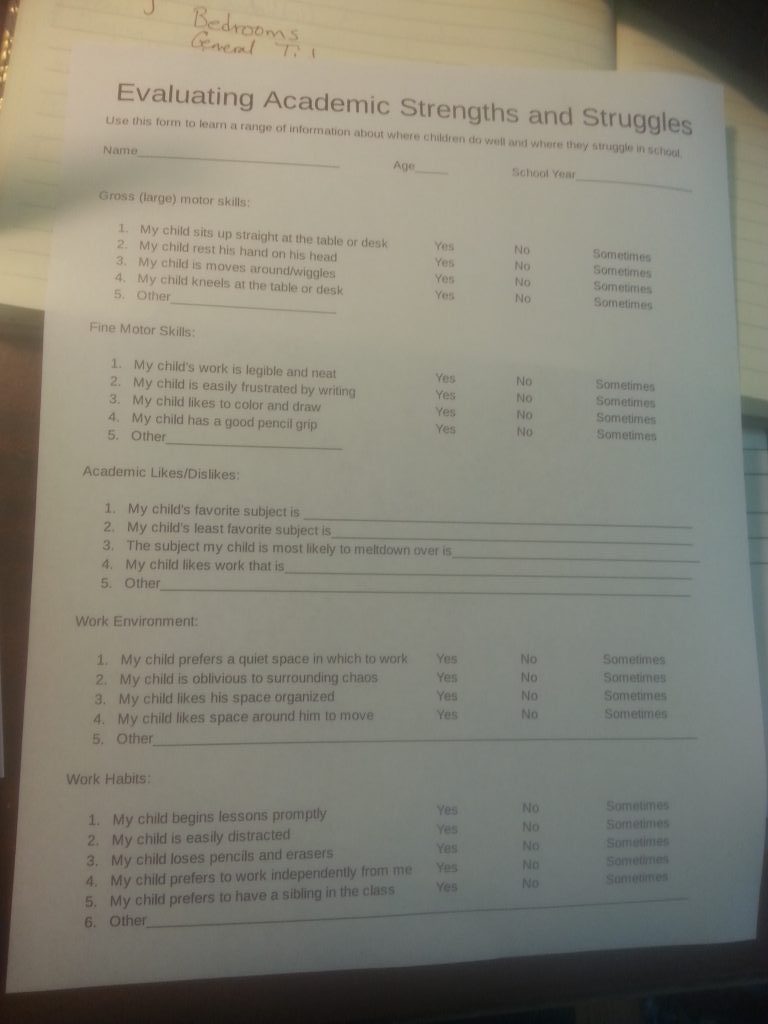
Today’s installment of the Finishing Strong! Series?is all about looking at a particular child’s strengths and struggles and using those to inform curriculum choices and plans for the next year. Strengths can make lessons easy – even too easy at times- and struggles can make every lesson a wrestling match between a child and the material to be mastered or between our children and ourselves! In order to accurately determine what kinds of work we should be asking our children to do, we need to identify their strengths and weaknesses from the physical (motor skills, sensory perceptions) to the purely mental (executive function, language processing ). Some struggles may require professional help, while others simply need a healthy dose of time, patience, and creative instruction.
Home Evaluation
As mother-teachers we often have a sense of our children’s abilities, but it is important to sit down and list them. For one thing, their struggles often loom larger in our minds than reality would indicate and for another many times strengths can be used to offset weaknesses.? We need to the reality check and the guideance to be able to meet each child at his level and come alongside them as they grow.
Homeschooling gives us the freedom to give a child an exercise ball to sit on, spend time reviewing harder concepts, or offer work beyond their “level” in order to meet their interests and motivation in a particular subject.
Professional Services
I spend a good bit of time talking to parents about diagnosable learning struggles and many times I hear that the child has had an issue in an area for years while the parents hoped they would “grow out of it” or where unsure where to look for help. The availability of help varies a good bit from state to state, but state level homeschool organizations will know the law for their state and often have some resources themselves. HSLDA also has special needs councilors and is able to advise on state law.
My general rule for deciding to look for educational services or evaluations is: If the child has struggled in a particular area for 1-2 years and changes in instructional method or curriculum have made little to no difference, then it is time to seek an outside evaluation.
Here are a couple of resources that may be helpful:
The Testing Lady/Sarah Olbris?offers testing and evaluation as well as portfolio review (in Virginia)
Dr. Judi Munday? Testing and evaluation, help with writing individualized student education plans
Using the Student Strengths and Struggles Form
Download the?[download id=”5795″] and answer each question as quickly as possible. When marking a “Yes-No-Sometimes” form like this it is important not to overthink the answers. Simply put the answer that comes to mind first even if it makes you or your child “look bad”. We aren’t trying to impress anyone here but to get an accurate snapshot of a student’s typical interactions with their lessons and learning environment. You don’t have to show these to anyone. They are for your information and planning process.

Once you have filled out the form, make a few additional notes:
My child prefers crayons to pencils when coloring.
My child does fine when I read aloud while he is coloring
These kinds of notes may well become the accommodations that you provide in the next school year.
This afternoon I’ll be doing a Facebook Live video at 2 pm. I’ll post the video here afterwards.
Tomorrow we’ll start talking about what all of this means to the plan for the new year!
Don’t forget to enter the Giveaway for the Family Pass to the 2018 HEAV Convention
Simply post a comment about how you evaluate your children’s strengths and weaknesses!

